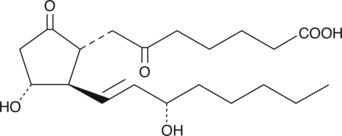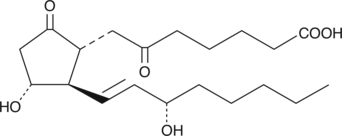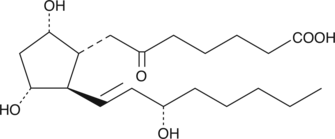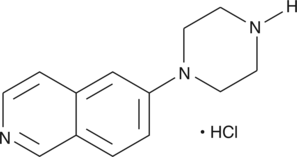Chemicals
Showing 6901–7050 of 41137 results
-
6-Formylindolo[3,2-b]carbazole (FICZ) is a degradation product of tryptophan upon exposure to visible light that activates the aryl hydrocarbon receptor (AhR; Kd = 70 pM).{31887} This endogenous AhR ligand is also a good substrate for cytochromes P450 (CYP) 1A1, 1A2, and 1B1 (Kis = 15.4, 3.9, and 13.3 µM, respectively).{31888} When activated by either environmental toxins or endogenous ligands, the AhR induces detoxifying enzymes and modulates immune cell differentiation. FICZ has been used to study the immunomodulatory and host defense mechanisms of AhR signaling pathways.{27028}
Brand:CaymanSKU:-Available on backorder
-
6-Formylindolo[3,2-b]carbazole (FICZ) is a degradation product of tryptophan upon exposure to visible light that activates the aryl hydrocarbon receptor (AhR; Kd = 70 pM).{31887} This endogenous AhR ligand is also a good substrate for cytochromes P450 (CYP) 1A1, 1A2, and 1B1 (Kis = 15.4, 3.9, and 13.3 µM, respectively).{31888} When activated by either environmental toxins or endogenous ligands, the AhR induces detoxifying enzymes and modulates immune cell differentiation. FICZ has been used to study the immunomodulatory and host defense mechanisms of AhR signaling pathways.{27028}
Brand:CaymanSKU:-Available on backorder
-
6-Formylindolo[3,2-b]carbazole (FICZ) is a degradation product of tryptophan upon exposure to visible light that activates the aryl hydrocarbon receptor (AhR; Kd = 70 pM).{31887} This endogenous AhR ligand is also a good substrate for cytochromes P450 (CYP) 1A1, 1A2, and 1B1 (Kis = 15.4, 3.9, and 13.3 µM, respectively).{31888} When activated by either environmental toxins or endogenous ligands, the AhR induces detoxifying enzymes and modulates immune cell differentiation. FICZ has been used to study the immunomodulatory and host defense mechanisms of AhR signaling pathways.{27028}
Brand:CaymanSKU:-Available on backorder
-
6-Formylindolo[3,2-b]carbazole (FICZ) is a degradation product of tryptophan upon exposure to visible light that activates the aryl hydrocarbon receptor (AhR; Kd = 70 pM).{31887} This endogenous AhR ligand is also a good substrate for cytochromes P450 (CYP) 1A1, 1A2, and 1B1 (Kis = 15.4, 3.9, and 13.3 µM, respectively).{31888} When activated by either environmental toxins or endogenous ligands, the AhR induces detoxifying enzymes and modulates immune cell differentiation. FICZ has been used to study the immunomodulatory and host defense mechanisms of AhR signaling pathways.{27028}
Brand:CaymanSKU:-Available on backorder
-
Xanthine oxidase (XO) generates reactive oxygen species, including hydrogen peroxide (H2O2), as it oxidizes specific substrates in the presence of water and oxygen.{15324} 6-Formylpterin is an oxidized pterin produced by photolytic breakdown of folic acid.{24043} It binds to one of two active sites on XO nearly quantitatively and irreversibly and prevents the metabolism of other substrates at the second site, resulting in “hetero-substrate” inhibition at nanomolar concentrations.{24043,24041} However, 6-formylpterin itself is converted by XO to 6-carboxylpterin and H2O2 and the turnover rate of this reaction can actually be accelerated by prior binding of a hetero-substrate to XO.{24041} In this way, 6-formylpterin acts as an intracellular generator of H2O2 in cells expressing XO, altering cellular function.{24042,24039}
Brand:CaymanSKU:- -
Xanthine oxidase (XO) generates reactive oxygen species, including hydrogen peroxide (H2O2), as it oxidizes specific substrates in the presence of water and oxygen.{15324} 6-Formylpterin is an oxidized pterin produced by photolytic breakdown of folic acid.{24043} It binds to one of two active sites on XO nearly quantitatively and irreversibly and prevents the metabolism of other substrates at the second site, resulting in “hetero-substrate” inhibition at nanomolar concentrations.{24043,24041} However, 6-formylpterin itself is converted by XO to 6-carboxylpterin and H2O2 and the turnover rate of this reaction can actually be accelerated by prior binding of a hetero-substrate to XO.{24041} In this way, 6-formylpterin acts as an intracellular generator of H2O2 in cells expressing XO, altering cellular function.{24042,24039}
Brand:CaymanSKU:- -
Xanthine oxidase (XO) generates reactive oxygen species, including hydrogen peroxide (H2O2), as it oxidizes specific substrates in the presence of water and oxygen.{15324} 6-Formylpterin is an oxidized pterin produced by photolytic breakdown of folic acid.{24043} It binds to one of two active sites on XO nearly quantitatively and irreversibly and prevents the metabolism of other substrates at the second site, resulting in “hetero-substrate” inhibition at nanomolar concentrations.{24043,24041} However, 6-formylpterin itself is converted by XO to 6-carboxylpterin and H2O2 and the turnover rate of this reaction can actually be accelerated by prior binding of a hetero-substrate to XO.{24041} In this way, 6-formylpterin acts as an intracellular generator of H2O2 in cells expressing XO, altering cellular function.{24042,24039}
Brand:CaymanSKU:- -
Xanthine oxidase (XO) generates reactive oxygen species, including hydrogen peroxide (H2O2), as it oxidizes specific substrates in the presence of water and oxygen.{15324} 6-Formylpterin is an oxidized pterin produced by photolytic breakdown of folic acid.{24043} It binds to one of two active sites on XO nearly quantitatively and irreversibly and prevents the metabolism of other substrates at the second site, resulting in “hetero-substrate” inhibition at nanomolar concentrations.{24043,24041} However, 6-formylpterin itself is converted by XO to 6-carboxylpterin and H2O2 and the turnover rate of this reaction can actually be accelerated by prior binding of a hetero-substrate to XO.{24041} In this way, 6-formylpterin acts as an intracellular generator of H2O2 in cells expressing XO, altering cellular function.{24042,24039}
Brand:CaymanSKU:- -
Xanthine oxidase (XO) generates reactive oxygen species, including hydrogen peroxide (H2O2), as it oxidizes specific substrates in the presence of water and oxygen.{15324} 6-Formylpterin is an oxidized pterin produced by photolytic breakdown of folic acid.{24043} It binds to one of two active sites on XO nearly quantitatively and irreversibly and prevents the metabolism of other substrates at the second site, resulting in “hetero-substrate” inhibition at nanomolar concentrations.{24043,24041} However, 6-formylpterin itself is converted by XO to 6-carboxylpterin and H2O2 and the turnover rate of this reaction can actually be accelerated by prior binding of a hetero-substrate to XO.{24041} In this way, 6-formylpterin acts as an intracellular generator of H2O2 in cells expressing XO, altering cellular function.{24042,24039}
Brand:CaymanSKU:- -
6-Gingerol is a natural chemical found in the rhizomes of ginger (Z. officinale). It shares the vanillyl group found on capsaicin (Item No. 92350) and, like capsaicin, activates the transient receptor potential vanilloid receptor TRPV1 (EC50 = 3.3 µM) as well as the TRP ankyrin receptor TRPA1 (EC50 = 10.4 µM).{25921} 6-Gingerol also non-competitively inhibits serotonin currents (IC50 = 30.3 µM) and weakly inhibits the cyclooxygenases COX-1 and COX-2 (IC50s = 129 and 125 µM).{25920,25922}
Brand:CaymanSKU:11707 - 1 mgAvailable on backorder
-
6-Gingerol is a natural chemical found in the rhizomes of ginger (Z. officinale). It shares the vanillyl group found on capsaicin (Item No. 92350) and, like capsaicin, activates the transient receptor potential vanilloid receptor TRPV1 (EC50 = 3.3 µM) as well as the TRP ankyrin receptor TRPA1 (EC50 = 10.4 µM).{25921} 6-Gingerol also non-competitively inhibits serotonin currents (IC50 = 30.3 µM) and weakly inhibits the cyclooxygenases COX-1 and COX-2 (IC50s = 129 and 125 µM).{25920,25922}
Brand:CaymanSKU:11707 - 10 mgAvailable on backorder
-
6-Gingerol is a natural chemical found in the rhizomes of ginger (Z. officinale). It shares the vanillyl group found on capsaicin (Item No. 92350) and, like capsaicin, activates the transient receptor potential vanilloid receptor TRPV1 (EC50 = 3.3 µM) as well as the TRP ankyrin receptor TRPA1 (EC50 = 10.4 µM).{25921} 6-Gingerol also non-competitively inhibits serotonin currents (IC50 = 30.3 µM) and weakly inhibits the cyclooxygenases COX-1 and COX-2 (IC50s = 129 and 125 µM).{25920,25922}
Brand:CaymanSKU:11707 - 25 mgAvailable on backorder
-
6-Gingerol is a natural chemical found in the rhizomes of ginger (Z. officinale). It shares the vanillyl group found on capsaicin (Item No. 92350) and, like capsaicin, activates the transient receptor potential vanilloid receptor TRPV1 (EC50 = 3.3 µM) as well as the TRP ankyrin receptor TRPA1 (EC50 = 10.4 µM).{25921} 6-Gingerol also non-competitively inhibits serotonin currents (IC50 = 30.3 µM) and weakly inhibits the cyclooxygenases COX-1 and COX-2 (IC50s = 129 and 125 µM).{25920,25922}
Brand:CaymanSKU:11707 - 5 mgAvailable on backorder
-
6-hydroxy Bexarotene is an oxidative metabolite of bexarotene (Item No. 11571), a high-affinity ligand for retinoid X receptors (RXRs).{35324} 6-hydroxy Bexarotene binds to RXRα, RXRβ, and RXRγ as well as retinoic acid receptor α (RARα; Kds = 3.46, 4.21, 4.83, and 8.17 μM, respectively). It selectively activates RXRα, RXRβ, and RXRγ over RARα, RARβ, and RARγ in vitro (EC50s = 398, 356, 420, 4,414, 2,121, and 2,043 nM, respectively).
Brand:CaymanSKU:22098 -Out of stock
-
6-hydroxy Bexarotene is an oxidative metabolite of bexarotene (Item No. 11571), a high-affinity ligand for retinoid X receptors (RXRs).{35324} 6-hydroxy Bexarotene binds to RXRα, RXRβ, and RXRγ as well as retinoic acid receptor α (RARα; Kds = 3.46, 4.21, 4.83, and 8.17 μM, respectively). It selectively activates RXRα, RXRβ, and RXRγ over RARα, RARβ, and RARγ in vitro (EC50s = 398, 356, 420, 4,414, 2,121, and 2,043 nM, respectively).
Brand:CaymanSKU:22098 -Out of stock
-
6-hydroxy Bexarotene is an oxidative metabolite of bexarotene (Item No. 11571), a high-affinity ligand for retinoid X receptors (RXRs).{35324} 6-hydroxy Bexarotene binds to RXRα, RXRβ, and RXRγ as well as retinoic acid receptor α (RARα; Kds = 3.46, 4.21, 4.83, and 8.17 μM, respectively). It selectively activates RXRα, RXRβ, and RXRγ over RARα, RARβ, and RARγ in vitro (EC50s = 398, 356, 420, 4,414, 2,121, and 2,043 nM, respectively).
Brand:CaymanSKU:22098 -Out of stock
-
6-hydroxy Chlorzoxazone is a metabolite of chlorzoxazone (Item No. 18869).{14227} It is formed by metabolism of chlorzoxazone by the cytochrome P450 (CYP) isoform CYP2E1 in human hepatic microsomes.
Brand:CaymanSKU:10009029 - 1 mgAvailable on backorder
-
6-hydroxy Chlorzoxazone is a metabolite of chlorzoxazone (Item No. 18869).{14227} It is formed by metabolism of chlorzoxazone by the cytochrome P450 (CYP) isoform CYP2E1 in human hepatic microsomes.
Brand:CaymanSKU:10009029 - 10 mgAvailable on backorder
-
6-hydroxy Chlorzoxazone is a metabolite of chlorzoxazone (Item No. 18869).{14227} It is formed by metabolism of chlorzoxazone by the cytochrome P450 (CYP) isoform CYP2E1 in human hepatic microsomes.
Brand:CaymanSKU:10009029 - 5 mgAvailable on backorder
-
6-hydroxy Melatonin is the primary active metabolite of melatonin (Item No. 14427). 6-hydroxy Melatonin acts as an agonist at the melatonin 1 (MT1) and MT2 receptors, with approximately the same potency as melatonin in a competition assay using [3H]-melatonin and human recombinant receptors (pKi = 9.23 and 9.93, respectively for MT1; 8.79 and 9.65, respectively for MT2).{34286} Melatonin is an indoleamine neurohormone whose levels vary in a daily cycle, thereby allowing the entrainment of the circadian rhythms of several biological functions in animals, plants, and microbes.{22956} Melatonin also has antioxidative properties, but 6-hydroxy melatonin is a better scavenger of reactive oxygen species than melatonin in rat brain homogenates.{34285,34287}
Brand:CaymanSKU:21857 -Out of stock
-
6-hydroxy Melatonin is the primary active metabolite of melatonin (Item No. 14427). 6-hydroxy Melatonin acts as an agonist at the melatonin 1 (MT1) and MT2 receptors, with approximately the same potency as melatonin in a competition assay using [3H]-melatonin and human recombinant receptors (pKi = 9.23 and 9.93, respectively for MT1; 8.79 and 9.65, respectively for MT2).{34286} Melatonin is an indoleamine neurohormone whose levels vary in a daily cycle, thereby allowing the entrainment of the circadian rhythms of several biological functions in animals, plants, and microbes.{22956} Melatonin also has antioxidative properties, but 6-hydroxy melatonin is a better scavenger of reactive oxygen species than melatonin in rat brain homogenates.{34285,34287}
Brand:CaymanSKU:21857 -Out of stock
-
6-hydroxy Melatonin is the primary active metabolite of melatonin (Item No. 14427). 6-hydroxy Melatonin acts as an agonist at the melatonin 1 (MT1) and MT2 receptors, with approximately the same potency as melatonin in a competition assay using [3H]-melatonin and human recombinant receptors (pKi = 9.23 and 9.93, respectively for MT1; 8.79 and 9.65, respectively for MT2).{34286} Melatonin is an indoleamine neurohormone whose levels vary in a daily cycle, thereby allowing the entrainment of the circadian rhythms of several biological functions in animals, plants, and microbes.{22956} Melatonin also has antioxidative properties, but 6-hydroxy melatonin is a better scavenger of reactive oxygen species than melatonin in rat brain homogenates.{34285,34287}
Brand:CaymanSKU:21857 -Out of stock
-
Brand:CaymanSKU:28587 - 1 mg
Available on backorder
-
6-hydroxy Warfarin is a metabolite of (+)-warfarin (Item No. 13526), which is a weaker vitamin K antagonist than (-)-warfarin (Item No. 13531).{34754, 34753,17423} Both isomers of warfarin are metabolized by the cytochrome P450 isoform 2C9 (CYP2C9); however, stereoselective metabolism also occurs, with CYP1A1 and CYP1A2 primarily responsible for metabolism of (+)-warfarin to 6-hydroxy warfarin.{34754,34753}
Brand:CaymanSKU:9000632 - 1 mgAvailable on backorder
-
6-hydroxy Warfarin is a metabolite of (+)-warfarin (Item No. 13526), which is a weaker vitamin K antagonist than (-)-warfarin (Item No. 13531).{34754, 34753,17423} Both isomers of warfarin are metabolized by the cytochrome P450 isoform 2C9 (CYP2C9); however, stereoselective metabolism also occurs, with CYP1A1 and CYP1A2 primarily responsible for metabolism of (+)-warfarin to 6-hydroxy warfarin.{34754,34753}
Brand:CaymanSKU:9000632 - 10 mgAvailable on backorder
-
6-hydroxy Warfarin is a metabolite of (+)-warfarin (Item No. 13526), which is a weaker vitamin K antagonist than (-)-warfarin (Item No. 13531).{34754, 34753,17423} Both isomers of warfarin are metabolized by the cytochrome P450 isoform 2C9 (CYP2C9); however, stereoselective metabolism also occurs, with CYP1A1 and CYP1A2 primarily responsible for metabolism of (+)-warfarin to 6-hydroxy warfarin.{34754,34753}
Brand:CaymanSKU:9000632 - 5 mgAvailable on backorder
-
6-hydroxy Warfarin is a metabolite of (+)-warfarin (Item No. 13526), which is a weaker vitamin K antagonist than (-)-warfarin (Item No. 13531).{34754, 34753,17423} Both isomers of warfarin are metabolized by the cytochrome P450 isoform 2C9 (CYP2C9); however, stereoselective metabolism also occurs, with CYP1A1 and CYP1A2 primarily responsible for metabolism of (+)-warfarin to 6-hydroxy warfarin.{34754,34753}
Brand:CaymanSKU:9000632 - 500 µgAvailable on backorder
-
6-Hydroxypyridin-3-ylboronic acid is a heterocyclic building block.{52494,52495} It has been used in the synthesis of non-nucleoside inhibitors of hepatitis C virus (HCV) RNA-dependent RNA polymerase nonstructural protein 5B (NS5B).{52494} 6-Hydroxypyridin-3-ylboronic acid has also been used in the synthesis of mammalian target of rapamycin (mTOR) inhibitors.{52495}
Brand:CaymanSKU:30492 - 100 mgAvailable on backorder
-
6-Hydroxypyridin-3-ylboronic acid is a heterocyclic building block.{52494,52495} It has been used in the synthesis of non-nucleoside inhibitors of hepatitis C virus (HCV) RNA-dependent RNA polymerase nonstructural protein 5B (NS5B).{52494} 6-Hydroxypyridin-3-ylboronic acid has also been used in the synthesis of mammalian target of rapamycin (mTOR) inhibitors.{52495}
Brand:CaymanSKU:30492 - 250 mgAvailable on backorder
-
6-Hydroxypyridin-3-ylboronic acid is a heterocyclic building block.{52494,52495} It has been used in the synthesis of non-nucleoside inhibitors of hepatitis C virus (HCV) RNA-dependent RNA polymerase nonstructural protein 5B (NS5B).{52494} 6-Hydroxypyridin-3-ylboronic acid has also been used in the synthesis of mammalian target of rapamycin (mTOR) inhibitors.{52495}
Brand:CaymanSKU:30492 - 500 mgAvailable on backorder
-
6-IT (Item No. 13938) is an analytical reference standard that is structurally categorized as an amphetamine. The resolution of 6-IT and its (2-aminopropyl) indole positional isomers has been reported.{30151} This product is intended for forensic and research applications.
Brand:CaymanSKU:- -
6-IT (Item No. 13938) is an analytical reference standard that is structurally categorized as an amphetamine. The resolution of 6-IT and its (2-aminopropyl) indole positional isomers has been reported.{30151} This product is intended for forensic and research applications.
Brand:CaymanSKU:- -
6-IT (Item No. 13938) is an analytical reference standard that is structurally categorized as an amphetamine. The resolution of 6-IT and its (2-aminopropyl) indole positional isomers has been reported.{30151} This product is intended for forensic and research applications.
Brand:CaymanSKU:- -
6-keto PGE1 is a metabolite isolated after the incubation of PGI2 with rabbit liver microsomes.{6609} However, it is not produced in appreciable amounts following IV infusion of PGI2 in humans.{6610} 6-keto PGE1 is equipotent with PGI2 as a vasodilator; in most other aspects its activity resembles PGE1.{423}
Brand:CaymanSKU:- -
6-keto PGE1 is a metabolite isolated after the incubation of PGI2 with rabbit liver microsomes.{6609} However, it is not produced in appreciable amounts following IV infusion of PGI2 in humans.{6610} 6-keto PGE1 is equipotent with PGI2 as a vasodilator; in most other aspects its activity resembles PGE1.{423}
Brand:CaymanSKU:- -
6-keto PGE1 is a metabolite isolated after the incubation of PGI2 with rabbit liver microsomes.{6609} However, it is not produced in appreciable amounts following IV infusion of PGI2 in humans.{6610} 6-keto PGE1 is equipotent with PGI2 as a vasodilator; in most other aspects its activity resembles PGE1.{423}
Brand:CaymanSKU:- -
6-keto Prostaglandin E1 (6-keto PGE1) is a stable non-enzymatic hydrolysis product of prostacyclin (PGI2; Item No. 18220). 6-keto PGE1 is a metabolite isolated after the incubation of PGI2 with rabbit liver microsomes.{6609} However, it is not produced in appreciable amounts following IV infusion of PGI2 in humans.{6610} 6-keto PGE1 is equipotent with PGI2 as a vasodilator; in most other aspects its activity resembles PGE1 (Item No. 13010).{423} 6-keto PGE1 MaxSpec® standard is a quantitative grade standard of 6-keto PGE1 (Item No. 13260) that has been prepared specifically for mass spectrometry or any application where quantitative reproducibility is required. The solution has been prepared gravimetrically and is supplied in a deactivated glass ampule sealed under argon. The concentration was verified by comparison to an independently prepared calibration standard. This 6-keto PGE1 MaxSpec® standard is guaranteed to meet identity, purity, stability, and concentration specifications and is provided with a batch-specific certificate of analysis. Ongoing stability testing is performed to ensure the concentration remains accurate throughout the shelf life of the product. Note: The amount of solution added to the vial is in excess of the listed amount. Therefore, it is necessary to accurately measure volumes for preparation of calibration standards. Follow recommended storage and handling conditions to maintain product quality.
Brand:CaymanSKU:10007210 - 100 µgAvailable on backorder
-
6-keto prostaglandin F1α (6-keto PGF1α) is the inactive, non-enzymatic hydrolysis product of PGI2.{441,443} 6-keto PGF1α serves as a useful marker of PGI2 biosynthesis in vivo.{439} When [3H]-PGI2 is injected into healthy human males, 6.6% of the radioactivity is recovered from urine as [3H]-6-keto PGF1α.{439}
Brand:CaymanSKU:- -
6-keto prostaglandin F1α (6-keto PGF1α) is the inactive, non-enzymatic hydrolysis product of PGI2.{441,443} 6-keto PGF1α serves as a useful marker of PGI2 biosynthesis in vivo.{439} When [3H]-PGI2 is injected into healthy human males, 6.6% of the radioactivity is recovered from urine as [3H]-6-keto PGF1α.{439}
Brand:CaymanSKU:- -
6-keto prostaglandin F1α (6-keto PGF1α) is the inactive, non-enzymatic hydrolysis product of PGI2.{441,443} 6-keto PGF1α serves as a useful marker of PGI2 biosynthesis in vivo.{439} When [3H]-PGI2 is injected into healthy human males, 6.6% of the radioactivity is recovered from urine as [3H]-6-keto PGF1α.{439}
Brand:CaymanSKU:- -
6-keto Prostaglandin F1α (6-keto PGF1α) is the inactive, non-enzymatic hydrolysis product of PGI2 (Item No. 18220).{441,443} 6-keto PGF1α serves as a useful marker of PGI2 biosynthesis in vivo.{439} When [3H]-PGI2 is injected into healthy human males, 6.6% of the radioactivity is recovered from urine as [3H]-6-keto PGF1α.{439} 6-keto PGF1α MaxSpec® standard is a quantitative grade standard of 6-keto PGF1α (Item No. 15210) that has been prepared specifically for mass spectrometry or any application where quantitative reproducibility is required. The solution has been prepared gravimetrically and is supplied in a deactivated glass ampule sealed under argon. The concentration was verified by comparison to an independently prepared calibration standard. This 6-keto PGF1α MaxSpec® standard is guaranteed to meet identity, purity, stability, and concentration specifications and is provided with a batch-specific certificate of analysis. Ongoing stability testing is performed to ensure the concentration remains accurate throughout the shelf life of the product. Note: The amount of solution added to the vial is in excess of the listed amount. Therefore, it is necessary to accurately measure volumes for preparation of calibration standards. Follow recommended storage and handling conditions to maintain product quality.
Brand:CaymanSKU:10007219 - 100 µgAvailable on backorder
-
6-keto Prostaglandin F1α-d4 (6-keto PGF1α-d4) contains four deuterium atoms at the 3, 3′, 4, and 4′ positions. It is intended for use as an internal standard for the quantification of 6-keto PGF1α (Item No. 15210) by GC- or LC-MS. 6-keto PGF1α is the inactive, non-enzymatic hydrolysis product of PGI2.{441,443} 6-keto PGF1α serves as a useful marker of PGI2 biosynthesis in vivo.{439} When [3H]-PGI2 is injected into healthy human males, 6.6% of the radioactivity is recovered from urine as [3H]-6-keto PGF1α.{439}
Brand:CaymanSKU:315210 - 1 mgAvailable on backorder
-
6-keto Prostaglandin F1α-d4 (6-keto PGF1α-d4) contains four deuterium atoms at the 3, 3′, 4, and 4′ positions. It is intended for use as an internal standard for the quantification of 6-keto PGF1α (Item No. 15210) by GC- or LC-MS. 6-keto PGF1α is the inactive, non-enzymatic hydrolysis product of PGI2.{441,443} 6-keto PGF1α serves as a useful marker of PGI2 biosynthesis in vivo.{439} When [3H]-PGI2 is injected into healthy human males, 6.6% of the radioactivity is recovered from urine as [3H]-6-keto PGF1α.{439}
Brand:CaymanSKU:315210 - 100 µgAvailable on backorder
-
6-keto Prostaglandin F1α-d4 (6-keto PGF1α-d4) contains four deuterium atoms at the 3, 3′, 4, and 4′ positions. It is intended for use as an internal standard for the quantification of 6-keto PGF1α (Item No. 15210) by GC- or LC-MS. 6-keto PGF1α is the inactive, non-enzymatic hydrolysis product of PGI2.{441,443} 6-keto PGF1α serves as a useful marker of PGI2 biosynthesis in vivo.{439} When [3H]-PGI2 is injected into healthy human males, 6.6% of the radioactivity is recovered from urine as [3H]-6-keto PGF1α.{439}
Brand:CaymanSKU:315210 - 25 µgAvailable on backorder
-
6-keto Prostaglandin F1α-d4 (6-keto PGF1α-d4) contains four deuterium atoms at the 3, 3′, 4, and 4′ positions. It is intended for use as an internal standard for the quantification of 6-keto PGF1α (Item No. 15210) by GC- or LC-MS. 6-keto PGF1α is the inactive, non-enzymatic hydrolysis product of PGI2.{441,443} 6-keto PGF1α serves as a useful marker of PGI2 biosynthesis in vivo.{439} When [3H]-PGI2 is injected into healthy human males, 6.6% of the radioactivity is recovered from urine as [3H]-6-keto PGF1α.{439}
Brand:CaymanSKU:315210 - 50 µgAvailable on backorder
-
6-Mercaptopurine (6-MP) is an inhibitor of purine synthesis and interconversion.{36297} It is rapidly converted to 6-mercaptopurine ribonucleoside-5′-monophosphate, which inhibits phosphoribosyl pyrophosphate (PRPP) amidotransferase, the rate-limiting enzyme in purine synthesis. It also inhibits the conversion of IMP to adenylosuccinic acid and xanthylic acid and blocks AMP formation in vitro. 6-MP (30 mg/kg) inhibits growth of sarcoma 180, adenocarcinoma E 0771, and adenocarcinoma 755 tumors and reduces the size of leukemia L1210 subcutaneous growths in mice.{36298} It also decreases delayed-type hypersensitivity and thyroid inflammation in a guinea pig model of thyroiditis when administered pre- or post-disease onset.{36299} Formulations containing mercaptopurine have been used for maintenance therapy in patients with acute lymphoblastic leukemia.{36300}
Brand:CaymanSKU:23675 - 10 gAvailable on backorder
-
6-Mercaptopurine (6-MP) is an inhibitor of purine synthesis and interconversion.{36297} It is rapidly converted to 6-mercaptopurine ribonucleoside-5′-monophosphate, which inhibits phosphoribosyl pyrophosphate (PRPP) amidotransferase, the rate-limiting enzyme in purine synthesis. It also inhibits the conversion of IMP to adenylosuccinic acid and xanthylic acid and blocks AMP formation in vitro. 6-MP (30 mg/kg) inhibits growth of sarcoma 180, adenocarcinoma E 0771, and adenocarcinoma 755 tumors and reduces the size of leukemia L1210 subcutaneous growths in mice.{36298} It also decreases delayed-type hypersensitivity and thyroid inflammation in a guinea pig model of thyroiditis when administered pre- or post-disease onset.{36299} Formulations containing mercaptopurine have been used for maintenance therapy in patients with acute lymphoblastic leukemia.{36300}
Brand:CaymanSKU:23675 - 25 gAvailable on backorder
-
6-Mercaptopurine (6-MP) is an inhibitor of purine synthesis and interconversion.{36297} It is rapidly converted to 6-mercaptopurine ribonucleoside-5′-monophosphate, which inhibits phosphoribosyl pyrophosphate (PRPP) amidotransferase, the rate-limiting enzyme in purine synthesis. It also inhibits the conversion of IMP to adenylosuccinic acid and xanthylic acid and blocks AMP formation in vitro. 6-MP (30 mg/kg) inhibits growth of sarcoma 180, adenocarcinoma E 0771, and adenocarcinoma 755 tumors and reduces the size of leukemia L1210 subcutaneous growths in mice.{36298} It also decreases delayed-type hypersensitivity and thyroid inflammation in a guinea pig model of thyroiditis when administered pre- or post-disease onset.{36299} Formulations containing mercaptopurine have been used for maintenance therapy in patients with acute lymphoblastic leukemia.{36300}
Brand:CaymanSKU:23675 - 5 gAvailable on backorder
-
6-MNA is a competitive, non-selective COX inhibitor.{1286,1364,1791} The Ki values for ovine COX-1 and -2 are 21 and 19 µM, respectively.{1364} The IC50 values are 70 and 20 µM for human recombinant COX-1 and -2, respectively.{1286}
Brand:CaymanSKU:70620 - 10 mgAvailable on backorder
-
6-MNA is a competitive, non-selective COX inhibitor.{1286,1364,1791} The Ki values for ovine COX-1 and -2 are 21 and 19 µM, respectively.{1364} The IC50 values are 70 and 20 µM for human recombinant COX-1 and -2, respectively.{1286}
Brand:CaymanSKU:70620 - 100 mgAvailable on backorder
-
6-MNA is a competitive, non-selective COX inhibitor.{1286,1364,1791} The Ki values for ovine COX-1 and -2 are 21 and 19 µM, respectively.{1364} The IC50 values are 70 and 20 µM for human recombinant COX-1 and -2, respectively.{1286}
Brand:CaymanSKU:70620 - 5 mgAvailable on backorder
-
6-MNA is a competitive, non-selective COX inhibitor.{1286,1364,1791} The Ki values for ovine COX-1 and -2 are 21 and 19 µM, respectively.{1364} The IC50 values are 70 and 20 µM for human recombinant COX-1 and -2, respectively.{1286}
Brand:CaymanSKU:70620 - 50 mgAvailable on backorder
-
6-Methylsulfinylhexyl isothiocyanate (6-MSITC) is an isothiocyanate that has been found in wasabi (W. japonica) and has diverse biological activities.{31411,31409,54330,31410,54331} It inhibits nitric oxide (NO) production in mouse peritoneal exudate macrophages when used at a concentration of 5 µM.{31411} It inhibits aggregation of isolated human platelets induced by arachidonic acid (Item Nos. 90010 | 90010.1 | 10006607; IC50 = 21.9 µM).{31409} 6-MSITC reduces cell survival in a panel of breast, brain, colon, lung, ovarian, renal, and prostate cancer cell lines (mean IC50 = 43.7 µM).{54330} In vivo, 6-MSITC (5 mg/kg twice weekly) reduces apoptosis of substantia nigral dopaminergic neurons and motor dysfunction in a mouse model of Parkinson’s disease induced by 6-OHDA (Item No. 25330).{31410} 6-MSITC also reduces the number of lung metastases in a B16/F10 murine melanoma model.{54331}
Brand:CaymanSKU:19638 -Available on backorder
-
6-Methylsulfinylhexyl isothiocyanate (6-MSITC) is an isothiocyanate that has been found in wasabi (W. japonica) and has diverse biological activities.{31411,31409,54330,31410,54331} It inhibits nitric oxide (NO) production in mouse peritoneal exudate macrophages when used at a concentration of 5 µM.{31411} It inhibits aggregation of isolated human platelets induced by arachidonic acid (Item Nos. 90010 | 90010.1 | 10006607; IC50 = 21.9 µM).{31409} 6-MSITC reduces cell survival in a panel of breast, brain, colon, lung, ovarian, renal, and prostate cancer cell lines (mean IC50 = 43.7 µM).{54330} In vivo, 6-MSITC (5 mg/kg twice weekly) reduces apoptosis of substantia nigral dopaminergic neurons and motor dysfunction in a mouse model of Parkinson’s disease induced by 6-OHDA (Item No. 25330).{31410} 6-MSITC also reduces the number of lung metastases in a B16/F10 murine melanoma model.{54331}
Brand:CaymanSKU:19638 -Available on backorder
-
6-Methylsulfinylhexyl isothiocyanate (6-MSITC) is an isothiocyanate that has been found in wasabi (W. japonica) and has diverse biological activities.{31411,31409,54330,31410,54331} It inhibits nitric oxide (NO) production in mouse peritoneal exudate macrophages when used at a concentration of 5 µM.{31411} It inhibits aggregation of isolated human platelets induced by arachidonic acid (Item Nos. 90010 | 90010.1 | 10006607; IC50 = 21.9 µM).{31409} 6-MSITC reduces cell survival in a panel of breast, brain, colon, lung, ovarian, renal, and prostate cancer cell lines (mean IC50 = 43.7 µM).{54330} In vivo, 6-MSITC (5 mg/kg twice weekly) reduces apoptosis of substantia nigral dopaminergic neurons and motor dysfunction in a mouse model of Parkinson’s disease induced by 6-OHDA (Item No. 25330).{31410} 6-MSITC also reduces the number of lung metastases in a B16/F10 murine melanoma model.{54331}
Brand:CaymanSKU:19638 -Available on backorder
-
6-Methylsulfinylhexyl isothiocyanate (6-MSITC) is an isothiocyanate that has been found in wasabi (W. japonica) and has diverse biological activities.{31411,31409,54330,31410,54331} It inhibits nitric oxide (NO) production in mouse peritoneal exudate macrophages when used at a concentration of 5 µM.{31411} It inhibits aggregation of isolated human platelets induced by arachidonic acid (Item Nos. 90010 | 90010.1 | 10006607; IC50 = 21.9 µM).{31409} 6-MSITC reduces cell survival in a panel of breast, brain, colon, lung, ovarian, renal, and prostate cancer cell lines (mean IC50 = 43.7 µM).{54330} In vivo, 6-MSITC (5 mg/kg twice weekly) reduces apoptosis of substantia nigral dopaminergic neurons and motor dysfunction in a mouse model of Parkinson’s disease induced by 6-OHDA (Item No. 25330).{31410} 6-MSITC also reduces the number of lung metastases in a B16/F10 murine melanoma model.{54331}
Brand:CaymanSKU:19638 -Available on backorder
-
6-NBDG is a non-hydrolyzable fluorescent glucose analog that is used to monitor glucose uptake and transport in living cells.{33229,33230,33231} 6-NBDG has been validated as a probe for the glucose transporter GLUT1 in cells.{33228} The fluorophore NBD displays excitation/emission maxima of 465/535 nm.
Brand:CaymanSKU:- -
6-NBDG is a non-hydrolyzable fluorescent glucose analog that is used to monitor glucose uptake and transport in living cells.{33229,33230,33231} 6-NBDG has been validated as a probe for the glucose transporter GLUT1 in cells.{33228} The fluorophore NBD displays excitation/emission maxima of 465/535 nm.
Brand:CaymanSKU:- -
6-NBDG is a non-hydrolyzable fluorescent glucose analog that is used to monitor glucose uptake and transport in living cells.{33229,33230,33231} 6-NBDG has been validated as a probe for the glucose transporter GLUT1 in cells.{33228} The fluorophore NBD displays excitation/emission maxima of 465/535 nm.
Brand:CaymanSKU:- -
6-Nitroveratraldehyde is a photolabile H+-donor that releases acid when excited at 405 nm.{36196} It has been used for fluorescence imaging, in conjunction with the pH sensitive fluorescent probe cSNARF1, to study nuclear proton dynamics, acid venting from cancer cells, and hemoglobin-restricted diffusion in the cytoplasm of red blood cells.{36196,36197,36198} 6-Nitroveratraldehyde has also been used as a precursor for [18F]fluoride displacement reactions in the synthesis of NCA 6-[18F]fluoro-L-dopa that is used in positron emission tomography (PET) studies of dopaminergic systems.{36199}
Brand:CaymanSKU:23364 - 10 gAvailable on backorder
-
6-Nitroveratraldehyde is a photolabile H+-donor that releases acid when excited at 405 nm.{36196} It has been used for fluorescence imaging, in conjunction with the pH sensitive fluorescent probe cSNARF1, to study nuclear proton dynamics, acid venting from cancer cells, and hemoglobin-restricted diffusion in the cytoplasm of red blood cells.{36196,36197,36198} 6-Nitroveratraldehyde has also been used as a precursor for [18F]fluoride displacement reactions in the synthesis of NCA 6-[18F]fluoro-L-dopa that is used in positron emission tomography (PET) studies of dopaminergic systems.{36199}
Brand:CaymanSKU:23364 - 25 gAvailable on backorder
-
6-Nitroveratraldehyde is a photolabile H+-donor that releases acid when excited at 405 nm.{36196} It has been used for fluorescence imaging, in conjunction with the pH sensitive fluorescent probe cSNARF1, to study nuclear proton dynamics, acid venting from cancer cells, and hemoglobin-restricted diffusion in the cytoplasm of red blood cells.{36196,36197,36198} 6-Nitroveratraldehyde has also been used as a precursor for [18F]fluoride displacement reactions in the synthesis of NCA 6-[18F]fluoro-L-dopa that is used in positron emission tomography (PET) studies of dopaminergic systems.{36199}
Brand:CaymanSKU:23364 - 5 gAvailable on backorder
-
6-Nitroveratraldehyde is a photolabile H+-donor that releases acid when excited at 405 nm.{36196} It has been used for fluorescence imaging, in conjunction with the pH sensitive fluorescent probe cSNARF1, to study nuclear proton dynamics, acid venting from cancer cells, and hemoglobin-restricted diffusion in the cytoplasm of red blood cells.{36196,36197,36198} 6-Nitroveratraldehyde has also been used as a precursor for [18F]fluoride displacement reactions in the synthesis of NCA 6-[18F]fluoro-L-dopa that is used in positron emission tomography (PET) studies of dopaminergic systems.{36199}
Brand:CaymanSKU:23364 - 50 gAvailable on backorder
-
6-O-desmethyl Donepezil is an active metabolite of the acetylcholinesterase inhibitor donepezil (Item No. 13245).{42676} It is formed through dealkylation by the cytochrome P450 (CYP) isoform CYP2D6.{42677} It inhibits human ether a go-go (hERG) channels (IC50 = 1.5 µM in HEK293 cells expressing hERG).{42676}
Brand:CaymanSKU:27175 - 1 mgAvailable on backorder
-
6-O-desmethyl Donepezil is an active metabolite of the acetylcholinesterase inhibitor donepezil (Item No. 13245).{42676} It is formed through dealkylation by the cytochrome P450 (CYP) isoform CYP2D6.{42677} It inhibits human ether a go-go (hERG) channels (IC50 = 1.5 µM in HEK293 cells expressing hERG).{42676}
Brand:CaymanSKU:27175 - 5 mgAvailable on backorder
-
6-O-desmethyl Donepezil is an active metabolite of the acetylcholinesterase inhibitor donepezil (Item No. 13245).{42676} It is formed through dealkylation by the cytochrome P450 (CYP) isoform CYP2D6.{42677} It inhibits human ether a go-go (hERG) channels (IC50 = 1.5 µM in HEK293 cells expressing hERG).{42676}
Brand:CaymanSKU:27175 - 500 µgAvailable on backorder
-
6-O-Sulfo-β-cyclodextrin is a sulfated cyclodextrin.{56041} It has been used for the chiral separation of nadolol racemates by capillary electrophoresis.
Brand:CaymanSKU:30168 - 100 mgAvailable on backorder
-
6-O-Sulfo-β-cyclodextrin is a sulfated cyclodextrin.{56041} It has been used for the chiral separation of nadolol racemates by capillary electrophoresis.
Brand:CaymanSKU:30168 - 250 mgAvailable on backorder
-
6-O-Sulfo-β-cyclodextrin is a sulfated cyclodextrin.{56041} It has been used for the chiral separation of nadolol racemates by capillary electrophoresis.
Brand:CaymanSKU:30168 - 50 mgAvailable on backorder
-
GPR84 is a Gαi protein-coupled receptor that is activated by medium-chain free fatty acids, but only at micromolar concentrations.{27421} GPR84 is expressed in leukocytes and its expression is further induced by LPS.{27421,29190} 6-OAU is a synthetic agonist for GPR84 (EC50 = 512 nM).{29190} It has insignificant actions at a panel of 69 other receptors, channels, or transporters.{29190} 6-OAU promotes chemotaxis in human neutrophils (EC50 = 318 nM) and amplifies TNF-α production by LPS-treated U937 macrophages.{29190} In rats, 6-OAU (1 mg/ml) drives the recruitment of neutrophils and macrophages when injected into a subcutaneous air pouch and raises serum levels of CXCL1 (growth-regulated α protein) when delivered intravenously.{29190}
Brand:CaymanSKU:-Available on backorder
-
GPR84 is a Gαi protein-coupled receptor that is activated by medium-chain free fatty acids, but only at micromolar concentrations.{27421} GPR84 is expressed in leukocytes and its expression is further induced by LPS.{27421,29190} 6-OAU is a synthetic agonist for GPR84 (EC50 = 512 nM).{29190} It has insignificant actions at a panel of 69 other receptors, channels, or transporters.{29190} 6-OAU promotes chemotaxis in human neutrophils (EC50 = 318 nM) and amplifies TNF-α production by LPS-treated U937 macrophages.{29190} In rats, 6-OAU (1 mg/ml) drives the recruitment of neutrophils and macrophages when injected into a subcutaneous air pouch and raises serum levels of CXCL1 (growth-regulated α protein) when delivered intravenously.{29190}
Brand:CaymanSKU:-Available on backorder
-
GPR84 is a Gαi protein-coupled receptor that is activated by medium-chain free fatty acids, but only at micromolar concentrations.{27421} GPR84 is expressed in leukocytes and its expression is further induced by LPS.{27421,29190} 6-OAU is a synthetic agonist for GPR84 (EC50 = 512 nM).{29190} It has insignificant actions at a panel of 69 other receptors, channels, or transporters.{29190} 6-OAU promotes chemotaxis in human neutrophils (EC50 = 318 nM) and amplifies TNF-α production by LPS-treated U937 macrophages.{29190} In rats, 6-OAU (1 mg/ml) drives the recruitment of neutrophils and macrophages when injected into a subcutaneous air pouch and raises serum levels of CXCL1 (growth-regulated α protein) when delivered intravenously.{29190}
Brand:CaymanSKU:-Available on backorder
-
6-OHDA is a catecholaminergic neurotoxin that has been used to induce dopaminergic lesions and parkinsonian symptoms as a model of Parkinson’s disease in rodents.{37722} It induces locomotor impairment in mice and loss of tyrosine hydroxylase-reactive neurons in mouse brain when administered into the substantia nigra, medial forebrain bundle (MFB), or striatum at doses of 9, 6, and 18 μg, respectively.{37727} Intracisternal administration of 6-OHDA (200 μg) decreases dopamine (Item No. 21992) and norepinephrine (Item No. 16673) levels in rat brain.{37726} It induces apoptosis in primary rat cortical cells and PC12 rat adrenal cells when used at a concentration of 50 μM.{37723,37724} 6-OHDA (75 μM) activates caspase-3, -8, and -9 in a time-dependent manner and increases the level of intracellular reactive oxygen species (ROS) in PC12 cells and induces apoptosis in rat substantia nigra when stereotaxically injected into the right MFB.{37724,37725}
Brand:CaymanSKU:25330 - 1 gAvailable on backorder
-
6-OHDA is a catecholaminergic neurotoxin that has been used to induce dopaminergic lesions and parkinsonian symptoms as a model of Parkinson’s disease in rodents.{37722} It induces locomotor impairment in mice and loss of tyrosine hydroxylase-reactive neurons in mouse brain when administered into the substantia nigra, medial forebrain bundle (MFB), or striatum at doses of 9, 6, and 18 μg, respectively.{37727} Intracisternal administration of 6-OHDA (200 μg) decreases dopamine (Item No. 21992) and norepinephrine (Item No. 16673) levels in rat brain.{37726} It induces apoptosis in primary rat cortical cells and PC12 rat adrenal cells when used at a concentration of 50 μM.{37723,37724} 6-OHDA (75 μM) activates caspase-3, -8, and -9 in a time-dependent manner and increases the level of intracellular reactive oxygen species (ROS) in PC12 cells and induces apoptosis in rat substantia nigra when stereotaxically injected into the right MFB.{37724,37725}
Brand:CaymanSKU:25330 - 250 mgAvailable on backorder
-
6-OHDA is a catecholaminergic neurotoxin that has been used to induce dopaminergic lesions and parkinsonian symptoms as a model of Parkinson’s disease in rodents.{37722} It induces locomotor impairment in mice and loss of tyrosine hydroxylase-reactive neurons in mouse brain when administered into the substantia nigra, medial forebrain bundle (MFB), or striatum at doses of 9, 6, and 18 μg, respectively.{37727} Intracisternal administration of 6-OHDA (200 μg) decreases dopamine (Item No. 21992) and norepinephrine (Item No. 16673) levels in rat brain.{37726} It induces apoptosis in primary rat cortical cells and PC12 rat adrenal cells when used at a concentration of 50 μM.{37723,37724} 6-OHDA (75 μM) activates caspase-3, -8, and -9 in a time-dependent manner and increases the level of intracellular reactive oxygen species (ROS) in PC12 cells and induces apoptosis in rat substantia nigra when stereotaxically injected into the right MFB.{37724,37725}
Brand:CaymanSKU:25330 - 50 mgAvailable on backorder
-
6-Paradol is a phenolic ketone that has been found in ginger (Z. officinale) and has diverse biological activities, including antioxidant, anti-inflammatory, and anti-hyperglycemic properties.{50301,50302,50303} It inhibits hydrogen peroxide-induced oxidation of cell-free calf thymus DNA when used at a concentration of 100 μM.{50301} In vitro, 6-paradol (10 μg/ml) inhibits LPS-induced nitric oxide (NO), IL-6, and TNF-α production by mouse BV-2 microglia.{50302} In vivo, 6-paradol (6.75 mg/kg per day) lowers blood glucose levels in an oral glucose tolerance test (OGTT) and inhibits weight-gain in a mouse model of high-fat diet-induced obesity.{50303}
Brand:CaymanSKU:27554 - 100 mgAvailable on backorder
-
6-Paradol is a phenolic ketone that has been found in ginger (Z. officinale) and has diverse biological activities, including antioxidant, anti-inflammatory, and anti-hyperglycemic properties.{50301,50302,50303} It inhibits hydrogen peroxide-induced oxidation of cell-free calf thymus DNA when used at a concentration of 100 μM.{50301} In vitro, 6-paradol (10 μg/ml) inhibits LPS-induced nitric oxide (NO), IL-6, and TNF-α production by mouse BV-2 microglia.{50302} In vivo, 6-paradol (6.75 mg/kg per day) lowers blood glucose levels in an oral glucose tolerance test (OGTT) and inhibits weight-gain in a mouse model of high-fat diet-induced obesity.{50303}
Brand:CaymanSKU:27554 - 25 mgAvailable on backorder
-
6-Paradol is a phenolic ketone that has been found in ginger (Z. officinale) and has diverse biological activities, including antioxidant, anti-inflammatory, and anti-hyperglycemic properties.{50301,50302,50303} It inhibits hydrogen peroxide-induced oxidation of cell-free calf thymus DNA when used at a concentration of 100 μM.{50301} In vitro, 6-paradol (10 μg/ml) inhibits LPS-induced nitric oxide (NO), IL-6, and TNF-α production by mouse BV-2 microglia.{50302} In vivo, 6-paradol (6.75 mg/kg per day) lowers blood glucose levels in an oral glucose tolerance test (OGTT) and inhibits weight-gain in a mouse model of high-fat diet-induced obesity.{50303}
Brand:CaymanSKU:27554 - 250 mgAvailable on backorder
-
6-Paradol is a phenolic ketone that has been found in ginger (Z. officinale) and has diverse biological activities, including antioxidant, anti-inflammatory, and anti-hyperglycemic properties.{50301,50302,50303} It inhibits hydrogen peroxide-induced oxidation of cell-free calf thymus DNA when used at a concentration of 100 μM.{50301} In vitro, 6-paradol (10 μg/ml) inhibits LPS-induced nitric oxide (NO), IL-6, and TNF-α production by mouse BV-2 microglia.{50302} In vivo, 6-paradol (6.75 mg/kg per day) lowers blood glucose levels in an oral glucose tolerance test (OGTT) and inhibits weight-gain in a mouse model of high-fat diet-induced obesity.{50303}
Brand:CaymanSKU:27554 - 50 mgAvailable on backorder
-
6-piperazin-1-yl-Isoquinoline (hydrochloride) is a synthetic intermediate useful for pharmaceutical synthesis.
Brand:CaymanSKU:10007148 - 1 gAvailable on backorder
-
6-piperazin-1-yl-Isoquinoline (hydrochloride) is a synthetic intermediate useful for pharmaceutical synthesis.
Brand:CaymanSKU:10007148 - 100 mgAvailable on backorder
-
6-piperazin-1-yl-Isoquinoline (hydrochloride) is a synthetic intermediate useful for pharmaceutical synthesis.
Brand:CaymanSKU:10007148 - 50 mgAvailable on backorder
-
6-piperazin-1-yl-Isoquinoline (hydrochloride) is a synthetic intermediate useful for pharmaceutical synthesis.
Brand:CaymanSKU:10007148 - 500 mgAvailable on backorder
-
6-Prenylindole is a bacterial metabolite that has been found in Streptomyces and has antifungal and antimalarial properties.{46404} It is active against A. brassicicola strain TP-F0423 and F. oxysporum f. sp. tulipae TU-4-2 (15 and 30 µg/disc in the paper disc assay), and also drug-resistant P. falciparum strain K1 (IC50 = 21 µg/ml).{46405}
Brand:CaymanSKU:28465 - 1 mgAvailable on backorder
-
6-Shogaol is a minor, bioactive component of ginger (Zingiber officinale Roscoe) with anti-inflammatory and anticancer properties. It is present in fresh ginger at low levels, but quantities of 6-shogaol are significantly increased in dried ginger. 6-Shogaol induces apoptosis in cancer cells through the production of reactive oxygen species and the activation of caspase, impairs tubulin polymerization, downregulates NF-κB signaling, inhibits the expression of inflammatory mediators, and suppresses Toll-like receptor signaling.{29734} 6-Shogaol-rich extracts have been shown to enhance antioxidant defense mechanisms by inducing Nrf2/ARE-mediated gene expression in cell and animal models.{29733} It can also activate both TRPV1 and TRPA1 channels (EC50s = 0.32 and 16 µM, respectively).{25921}
Brand:CaymanSKU:11901 - 1 mgAvailable on backorder
-
6-Shogaol is a minor, bioactive component of ginger (Zingiber officinale Roscoe) with anti-inflammatory and anticancer properties. It is present in fresh ginger at low levels, but quantities of 6-shogaol are significantly increased in dried ginger. 6-Shogaol induces apoptosis in cancer cells through the production of reactive oxygen species and the activation of caspase, impairs tubulin polymerization, downregulates NF-κB signaling, inhibits the expression of inflammatory mediators, and suppresses Toll-like receptor signaling.{29734} 6-Shogaol-rich extracts have been shown to enhance antioxidant defense mechanisms by inducing Nrf2/ARE-mediated gene expression in cell and animal models.{29733} It can also activate both TRPV1 and TRPA1 channels (EC50s = 0.32 and 16 µM, respectively).{25921}
Brand:CaymanSKU:11901 - 10 mgAvailable on backorder
-
6-Shogaol is a minor, bioactive component of ginger (Zingiber officinale Roscoe) with anti-inflammatory and anticancer properties. It is present in fresh ginger at low levels, but quantities of 6-shogaol are significantly increased in dried ginger. 6-Shogaol induces apoptosis in cancer cells through the production of reactive oxygen species and the activation of caspase, impairs tubulin polymerization, downregulates NF-κB signaling, inhibits the expression of inflammatory mediators, and suppresses Toll-like receptor signaling.{29734} 6-Shogaol-rich extracts have been shown to enhance antioxidant defense mechanisms by inducing Nrf2/ARE-mediated gene expression in cell and animal models.{29733} It can also activate both TRPV1 and TRPA1 channels (EC50s = 0.32 and 16 µM, respectively).{25921}
Brand:CaymanSKU:11901 - 5 mgAvailable on backorder
-
6-thio-2′-Deoxyguanosine (6-thio-dG) is a nucleoside analog that is incorporated into de novo-synthesized telomeres by telomerase.{31123,31124} This induces telomerase dysfunction resulting in telomeric DNA damage and rapid cell death.{31123} This process occurs in cells expressing telomerase but not in telomerase-negative cells.{31123} DNA containing 6-thio-dG inhibits the function of RNase H, preventing the cleavage of DNA-RNA heteroduplexes.{31122} In mouse xenograft studies using A549 lung cancer cells, 6-thio-dG causes a decrease in tumor growth rate associated with telomere dysfunction.{31123}
Brand:CaymanSKU:-Available on backorder
-
6-thio-2′-Deoxyguanosine (6-thio-dG) is a nucleoside analog that is incorporated into de novo-synthesized telomeres by telomerase.{31123,31124} This induces telomerase dysfunction resulting in telomeric DNA damage and rapid cell death.{31123} This process occurs in cells expressing telomerase but not in telomerase-negative cells.{31123} DNA containing 6-thio-dG inhibits the function of RNase H, preventing the cleavage of DNA-RNA heteroduplexes.{31122} In mouse xenograft studies using A549 lung cancer cells, 6-thio-dG causes a decrease in tumor growth rate associated with telomere dysfunction.{31123}
Brand:CaymanSKU:-Available on backorder
-
6-thio-2′-Deoxyguanosine (6-thio-dG) is a nucleoside analog that is incorporated into de novo-synthesized telomeres by telomerase.{31123,31124} This induces telomerase dysfunction resulting in telomeric DNA damage and rapid cell death.{31123} This process occurs in cells expressing telomerase but not in telomerase-negative cells.{31123} DNA containing 6-thio-dG inhibits the function of RNase H, preventing the cleavage of DNA-RNA heteroduplexes.{31122} In mouse xenograft studies using A549 lung cancer cells, 6-thio-dG causes a decrease in tumor growth rate associated with telomere dysfunction.{31123}
Brand:CaymanSKU:-Available on backorder
-
6-thio-2′-Deoxyguanosine (6-thio-dG) is a nucleoside analog that is incorporated into de novo-synthesized telomeres by telomerase.{31123,31124} This induces telomerase dysfunction resulting in telomeric DNA damage and rapid cell death.{31123} This process occurs in cells expressing telomerase but not in telomerase-negative cells.{31123} DNA containing 6-thio-dG inhibits the function of RNase H, preventing the cleavage of DNA-RNA heteroduplexes.{31122} In mouse xenograft studies using A549 lung cancer cells, 6-thio-dG causes a decrease in tumor growth rate associated with telomere dysfunction.{31123}
Brand:CaymanSKU:-Available on backorder
-
6-Thioguanine (6-TG) is a thio analog of the purine base guanine that incorporates into DNA during replication, inducing double-strand breaks that destabilize its structure and result in cytotoxicity.{25754,25756} Upon incorporation into DNA, 6-TG has been shown to disrupt cytosine methylation by DNA methyltransferases, interfering with the epigenetic pathway of gene regulation.{25757,25758} This compound has been used as a chemotherapeutic for acute leukemia and other types of cancer, including BRCA2-mutated tumors.{25755}
Brand:CaymanSKU:- -
6-Thioguanine (6-TG) is a thio analog of the purine base guanine that incorporates into DNA during replication, inducing double-strand breaks that destabilize its structure and result in cytotoxicity.{25754,25756} Upon incorporation into DNA, 6-TG has been shown to disrupt cytosine methylation by DNA methyltransferases, interfering with the epigenetic pathway of gene regulation.{25757,25758} This compound has been used as a chemotherapeutic for acute leukemia and other types of cancer, including BRCA2-mutated tumors.{25755}
Brand:CaymanSKU:- -
6-Thioguanine (6-TG) is a thio analog of the purine base guanine that incorporates into DNA during replication, inducing double-strand breaks that destabilize its structure and result in cytotoxicity.{25754,25756} Upon incorporation into DNA, 6-TG has been shown to disrupt cytosine methylation by DNA methyltransferases, interfering with the epigenetic pathway of gene regulation.{25757,25758} This compound has been used as a chemotherapeutic for acute leukemia and other types of cancer, including BRCA2-mutated tumors.{25755}
Brand:CaymanSKU:- -
6-Thioguanine (6-TG) is a thio analog of the purine base guanine that incorporates into DNA during replication, inducing double-strand breaks that destabilize its structure and result in cytotoxicity.{25754,25756} Upon incorporation into DNA, 6-TG has been shown to disrupt cytosine methylation by DNA methyltransferases, interfering with the epigenetic pathway of gene regulation.{25757,25758} This compound has been used as a chemotherapeutic for acute leukemia and other types of cancer, including BRCA2-mutated tumors.{25755}
Brand:CaymanSKU:- -
6-trans LTB4 is produced by the non-enzymatic hydrolysis of LTA4.{530} Oxidative decomposition of cysteinyl-leukotrienes such as LTC4 in the presence of myeloperoxidase and hypochlorous acid can also produce 6-trans LTB4, but the physiologic importance of this mechanism is not clear.{531} 6-trans LTB4 is relatively inactive compared to LTB4, but chemoattractant properties in neutrophils have been reported.{83}
Brand:CaymanSKU:35250 - 100 µgAvailable on backorder
-
6-trans LTB4 is produced by the non-enzymatic hydrolysis of LTA4.{530} Oxidative decomposition of cysteinyl-leukotrienes such as LTC4 in the presence of myeloperoxidase and hypochlorous acid can also produce 6-trans LTB4, but the physiologic importance of this mechanism is not clear.{531} 6-trans LTB4 is relatively inactive compared to LTB4, but chemoattractant properties in neutrophils have been reported.{83}
Brand:CaymanSKU:35250 - 25 µgAvailable on backorder
-
6-trans LTB4 is produced by the non-enzymatic hydrolysis of LTA4.{530} Oxidative decomposition of cysteinyl-leukotrienes such as LTC4 in the presence of myeloperoxidase and hypochlorous acid can also produce 6-trans LTB4, but the physiologic importance of this mechanism is not clear.{531} 6-trans LTB4 is relatively inactive compared to LTB4, but chemoattractant properties in neutrophils have been reported.{83}
Brand:CaymanSKU:35250 - 50 µgAvailable on backorder
-
6-trans-12-epi Leukotriene B4 (LTB4) is a non-enzymatic hydrolysis product of LTA4. It was originally isolated from glycogen-induced rabbit peritoneal polymorphonuclear leukocytes (PMNL).{530,523} 6-trans-12-epi LTB4 is weakly chemotactic for PMNL, with approximately 20 times less potency than LTB4, and has no effect on the aggregation response.{551}
Brand:CaymanSKU:35265 - 100 µgAvailable on backorder
-
6-trans-12-epi Leukotriene B4 (LTB4) is a non-enzymatic hydrolysis product of LTA4. It was originally isolated from glycogen-induced rabbit peritoneal polymorphonuclear leukocytes (PMNL).{530,523} 6-trans-12-epi LTB4 is weakly chemotactic for PMNL, with approximately 20 times less potency than LTB4, and has no effect on the aggregation response.{551}
Brand:CaymanSKU:35265 - 25 µgAvailable on backorder
-
6-trans-12-epi Leukotriene B4 (LTB4) is a non-enzymatic hydrolysis product of LTA4. It was originally isolated from glycogen-induced rabbit peritoneal polymorphonuclear leukocytes (PMNL).{530,523} 6-trans-12-epi LTB4 is weakly chemotactic for PMNL, with approximately 20 times less potency than LTB4, and has no effect on the aggregation response.{551}
Brand:CaymanSKU:35265 - 50 µgAvailable on backorder
-
6,15-diketo-13,14-dihydro PGF1α is a metabolite of PGI2. It was shown to enhance intracellular cAMP and cholesterol catabolism in bovine arterial smooth muscle cells.{1156}
Brand:CaymanSKU:- -
6,15-diketo-13,14-dihydro PGF1α is a metabolite of PGI2. It was shown to enhance intracellular cAMP and cholesterol catabolism in bovine arterial smooth muscle cells.{1156}
Brand:CaymanSKU:- -
6,15-diketo-13,14-dihydro PGF1α is a metabolite of PGI2. It was shown to enhance intracellular cAMP and cholesterol catabolism in bovine arterial smooth muscle cells.{1156}
Brand:CaymanSKU:- -
6,15-diketo-13,14-dihydro PGF1α is a metabolite of PGI2. It was shown to enhance intracellular cAMP and cholesterol catabolism in bovine arterial smooth muscle cells.{1156}
Brand:CaymanSKU:- -
6,7-Dihydro-5H-quinolin-8-one is a synthetic intermediate.{52481,52482} It has been used in the synthesis of tetrahydropyridoazepinones and thiosemicarbazones with anticancer activity.
Brand:CaymanSKU:30480 - 1 gAvailable on backorder
-
6,7-Dihydro-5H-quinolin-8-one is a synthetic intermediate.{52481,52482} It has been used in the synthesis of tetrahydropyridoazepinones and thiosemicarbazones with anticancer activity.
Brand:CaymanSKU:30480 - 5 gAvailable on backorder
-
6,7-Dihydro-5H-quinolin-8-one is a synthetic intermediate.{52481,52482} It has been used in the synthesis of tetrahydropyridoazepinones and thiosemicarbazones with anticancer activity.
Brand:CaymanSKU:30480 - 500 mgAvailable on backorder
-
6,7-dihydroxy Bergamottin (6,7-DHB) is a potent inhibitor of CYP3A4 (IC50 = 25 µM).{14836} It appears to be the primary compound in grapefruit juice that is responsible for inhibition of testosterone 6β-hydrolase activity. Ingestion of grapefruit juice during treatment regimes with drugs normally metabolized by cytochrome P450 enzymes of the CYP3A subfamily results in a substantial increase in plasma concentration of these agents.{14571,14836} However, giving a patient grapefruit juice or just 6,7-DHB could be advantageous in cases where a drug is metabolized too quickly by CYP3A4.
Brand:CaymanSKU:10009598 - 1 mgAvailable on backorder
-
6,7-dihydroxy Bergamottin (6,7-DHB) is a potent inhibitor of CYP3A4 (IC50 = 25 µM).{14836} It appears to be the primary compound in grapefruit juice that is responsible for inhibition of testosterone 6β-hydrolase activity. Ingestion of grapefruit juice during treatment regimes with drugs normally metabolized by cytochrome P450 enzymes of the CYP3A subfamily results in a substantial increase in plasma concentration of these agents.{14571,14836} However, giving a patient grapefruit juice or just 6,7-DHB could be advantageous in cases where a drug is metabolized too quickly by CYP3A4.
Brand:CaymanSKU:10009598 - 10 mgAvailable on backorder
-
6,7-dihydroxy Bergamottin (6,7-DHB) is a potent inhibitor of CYP3A4 (IC50 = 25 µM).{14836} It appears to be the primary compound in grapefruit juice that is responsible for inhibition of testosterone 6β-hydrolase activity. Ingestion of grapefruit juice during treatment regimes with drugs normally metabolized by cytochrome P450 enzymes of the CYP3A subfamily results in a substantial increase in plasma concentration of these agents.{14571,14836} However, giving a patient grapefruit juice or just 6,7-DHB could be advantageous in cases where a drug is metabolized too quickly by CYP3A4.
Brand:CaymanSKU:10009598 - 25 mgAvailable on backorder
-
6,7-dihydroxy Bergamottin (6,7-DHB) is a potent inhibitor of CYP3A4 (IC50 = 25 µM).{14836} It appears to be the primary compound in grapefruit juice that is responsible for inhibition of testosterone 6β-hydrolase activity. Ingestion of grapefruit juice during treatment regimes with drugs normally metabolized by cytochrome P450 enzymes of the CYP3A subfamily results in a substantial increase in plasma concentration of these agents.{14571,14836} However, giving a patient grapefruit juice or just 6,7-DHB could be advantageous in cases where a drug is metabolized too quickly by CYP3A4.
Brand:CaymanSKU:10009598 - 5 mgAvailable on backorder
-
6,7-dimethyl-5,6,7,8-Tetrahydropterin is a synthetic analog of tetrahydro-L-biopterin (BH4; Item No. 81880), a required cofactor for all NOS isoforms, phenylalanine, tyrosine, and tryptophan hydroxylases, and other enzymes.{1697,32923,32924,32925,32926}
Brand:CaymanSKU:21050 -Out of stock
-
6,7-dimethyl-5,6,7,8-Tetrahydropterin is a synthetic analog of tetrahydro-L-biopterin (BH4; Item No. 81880), a required cofactor for all NOS isoforms, phenylalanine, tyrosine, and tryptophan hydroxylases, and other enzymes.{1697,32923,32924,32925,32926}
Brand:CaymanSKU:21050 -Out of stock
-
6,7-dimethyl-5,6,7,8-Tetrahydropterin is a synthetic analog of tetrahydro-L-biopterin (BH4; Item No. 81880), a required cofactor for all NOS isoforms, phenylalanine, tyrosine, and tryptophan hydroxylases, and other enzymes.{1697,32923,32924,32925,32926}
Brand:CaymanSKU:21050 -Out of stock
-
6,7-dimethyl-5,6,7,8-Tetrahydropterin is a synthetic analog of tetrahydro-L-biopterin (BH4; Item No. 81880), a required cofactor for all NOS isoforms, phenylalanine, tyrosine, and tryptophan hydroxylases, and other enzymes.{1697,32923,32924,32925,32926}
Brand:CaymanSKU:21050 -Out of stock
-
6,7-dimethyl-8-Ribityllumazine (DMRL) is a natural chromophore of lumazine protein (LumP), a fluorescent accessory protein that induces a blue shift (495 to 475 nm) in luciferase emission wavelengths in bioluminescent Photobacterium.{39355} DMRL binds noncovalently to both the N- and C-terminal domains of LumP. It is also a biosynthetic precursor of riboflavin and substrate of riboflavin synthase.{39356}
Brand:CaymanSKU:23370 - 1 mgAvailable on backorder
-
6,7-Dimethylpterin is a pteridine that has been found in A549 cells, as well as human urine.{53828,53829}
Brand:CaymanSKU:30887 - 1 gAvailable on backorder
-
6,7-Dimethylpterin is a pteridine that has been found in A549 cells, as well as human urine.{53828,53829}
Brand:CaymanSKU:30887 - 100 mgAvailable on backorder
-
6,7-Dimethylpterin is a pteridine that has been found in A549 cells, as well as human urine.{53828,53829}
Brand:CaymanSKU:30887 - 250 mgAvailable on backorder
-
6,7-Dimethylpterin is a pteridine that has been found in A549 cells, as well as human urine.{53828,53829}
Brand:CaymanSKU:30887 - 500 mgAvailable on backorder
-
6,7-Dimethyltetrahydropterin is a noncompetitive inhibitor of GTP cyclohydrolase I exhibiting an IC50 of 76-112 µM.{1268}
Brand:CaymanSKU:81040 - 10 mgAvailable on backorder
-
6,7-Dimethyltetrahydropterin is a noncompetitive inhibitor of GTP cyclohydrolase I exhibiting an IC50 of 76-112 µM.{1268}
Brand:CaymanSKU:81040 - 100 mgAvailable on backorder
-
6,7-Dimethyltetrahydropterin is a noncompetitive inhibitor of GTP cyclohydrolase I exhibiting an IC50 of 76-112 µM.{1268}
Brand:CaymanSKU:81040 - 50 mgAvailable on backorder
-
6,7-Dimethyltetrahydropterin is a noncompetitive inhibitor of GTP cyclohydrolase I exhibiting an IC50 of 76-112 µM.{1268}
Brand:CaymanSKU:81040 - 500 mgAvailable on backorder
-
6,9-Dichloro-1,2,3,4-tetrahydroacridine is a synthetic intermediate in the synthesis of tacrine-based acetylcholinesterase (AChE) inhibitors.{54104} It is also an intermediate in the synthesis of multifunctional tacrine hybrids that possess radical scavenging, amyloid-β aggregation inhibitory, and/or β-secretase 1 (BACE1) inhibitory activities in addition to their activity as AChE inhibitors.{54105,54106}
Brand:CaymanSKU:30502 - 100 mgAvailable on backorder
-
6,9-Dichloro-1,2,3,4-tetrahydroacridine is a synthetic intermediate in the synthesis of tacrine-based acetylcholinesterase (AChE) inhibitors.{54104} It is also an intermediate in the synthesis of multifunctional tacrine hybrids that possess radical scavenging, amyloid-β aggregation inhibitory, and/or β-secretase 1 (BACE1) inhibitory activities in addition to their activity as AChE inhibitors.{54105,54106}
Brand:CaymanSKU:30502 - 25 mgAvailable on backorder
-
6,9-Dichloro-1,2,3,4-tetrahydroacridine is a synthetic intermediate in the synthesis of tacrine-based acetylcholinesterase (AChE) inhibitors.{54104} It is also an intermediate in the synthesis of multifunctional tacrine hybrids that possess radical scavenging, amyloid-β aggregation inhibitory, and/or β-secretase 1 (BACE1) inhibitory activities in addition to their activity as AChE inhibitors.{54105,54106}
Brand:CaymanSKU:30502 - 250 mgAvailable on backorder
-
6,9-Dichloro-1,2,3,4-tetrahydroacridine is a synthetic intermediate in the synthesis of tacrine-based acetylcholinesterase (AChE) inhibitors.{54104} It is also an intermediate in the synthesis of multifunctional tacrine hybrids that possess radical scavenging, amyloid-β aggregation inhibitory, and/or β-secretase 1 (BACE1) inhibitory activities in addition to their activity as AChE inhibitors.{54105,54106}
Brand:CaymanSKU:30502 - 50 mgAvailable on backorder
-
6′-Sialyllactose consists of the monosaccharide N-acetylneuraminic acid (Item No. 16091) linked to the galactosyl subunit of lactose at the 6 position. This connection is at the 3 position in the related compound, 3’-sialyllactose (Item No. 16617). Both are major milk oligosaccharides that avidly bind several viral strains, including strains of influenza, HIV-1, reovirus, and polyomavirus.{27235,27232,27228,27229,27230,27234} These compounds can be used to differentiate and characterize the binding domains of viruses that recognize N-acetylneuraminic acid-capped cell surface receptors. They are also used as analytical reference standards for quantification in samples such as milk or colostrum.
Brand:CaymanSKU:-Available on backorder
-
6′-Sialyllactose consists of the monosaccharide N-acetylneuraminic acid (Item No. 16091) linked to the galactosyl subunit of lactose at the 6 position. This connection is at the 3 position in the related compound, 3’-sialyllactose (Item No. 16617). Both are major milk oligosaccharides that avidly bind several viral strains, including strains of influenza, HIV-1, reovirus, and polyomavirus.{27235,27232,27228,27229,27230,27234} These compounds can be used to differentiate and characterize the binding domains of viruses that recognize N-acetylneuraminic acid-capped cell surface receptors. They are also used as analytical reference standards for quantification in samples such as milk or colostrum.
Brand:CaymanSKU:-Available on backorder
-
6′-Sialyllactose consists of the monosaccharide N-acetylneuraminic acid (Item No. 16091) linked to the galactosyl subunit of lactose at the 6 position. This connection is at the 3 position in the related compound, 3’-sialyllactose (Item No. 16617). Both are major milk oligosaccharides that avidly bind several viral strains, including strains of influenza, HIV-1, reovirus, and polyomavirus.{27235,27232,27228,27229,27230,27234} These compounds can be used to differentiate and characterize the binding domains of viruses that recognize N-acetylneuraminic acid-capped cell surface receptors. They are also used as analytical reference standards for quantification in samples such as milk or colostrum.
Brand:CaymanSKU:-Available on backorder
-
6’7′-Epoxybergamottin is a furanocoumarin found in grapefruit.{40136} It is a potent inhibitor of the cytochrome P450 (CYP) isoform CYP3A4 with an IC50 value of 0.30 ppm in a cell-free assay, 0.33 µM in HL7 human liver cells, and 0.22 µM in S9 human intestine cells.{40137} It has been studied in the context of drug interactions with grapefruit constituents. It is found in grapefruit juice at concentrations of 0.1-7.4 µM and inhibits the transport of talinolol (Item No. 16116), a permeability glycoprotein (P-gp/ABCB1) transporter substrate, across Caco-2 cell monolayers (IC50 = 0.7 µM).{40135} 6’7’-Epoxybergamottin also has insecticidal properties with a concentration of 5 µg/cm2 leading to 100% mortality of adult olive fruit flies.{40138}
Brand:CaymanSKU:19760 -Available on backorder
-
6’7′-Epoxybergamottin is a furanocoumarin found in grapefruit.{40136} It is a potent inhibitor of the cytochrome P450 (CYP) isoform CYP3A4 with an IC50 value of 0.30 ppm in a cell-free assay, 0.33 µM in HL7 human liver cells, and 0.22 µM in S9 human intestine cells.{40137} It has been studied in the context of drug interactions with grapefruit constituents. It is found in grapefruit juice at concentrations of 0.1-7.4 µM and inhibits the transport of talinolol (Item No. 16116), a permeability glycoprotein (P-gp/ABCB1) transporter substrate, across Caco-2 cell monolayers (IC50 = 0.7 µM).{40135} 6’7’-Epoxybergamottin also has insecticidal properties with a concentration of 5 µg/cm2 leading to 100% mortality of adult olive fruit flies.{40138}
Brand:CaymanSKU:19760 -Available on backorder
-
6’7′-Epoxybergamottin is a furanocoumarin found in grapefruit.{40136} It is a potent inhibitor of the cytochrome P450 (CYP) isoform CYP3A4 with an IC50 value of 0.30 ppm in a cell-free assay, 0.33 µM in HL7 human liver cells, and 0.22 µM in S9 human intestine cells.{40137} It has been studied in the context of drug interactions with grapefruit constituents. It is found in grapefruit juice at concentrations of 0.1-7.4 µM and inhibits the transport of talinolol (Item No. 16116), a permeability glycoprotein (P-gp/ABCB1) transporter substrate, across Caco-2 cell monolayers (IC50 = 0.7 µM).{40135} 6’7’-Epoxybergamottin also has insecticidal properties with a concentration of 5 µg/cm2 leading to 100% mortality of adult olive fruit flies.{40138}
Brand:CaymanSKU:19760 -Available on backorder
-
6’7′-Epoxybergamottin is a furanocoumarin found in grapefruit.{40136} It is a potent inhibitor of the cytochrome P450 (CYP) isoform CYP3A4 with an IC50 value of 0.30 ppm in a cell-free assay, 0.33 µM in HL7 human liver cells, and 0.22 µM in S9 human intestine cells.{40137} It has been studied in the context of drug interactions with grapefruit constituents. It is found in grapefruit juice at concentrations of 0.1-7.4 µM and inhibits the transport of talinolol (Item No. 16116), a permeability glycoprotein (P-gp/ABCB1) transporter substrate, across Caco-2 cell monolayers (IC50 = 0.7 µM).{40135} 6’7’-Epoxybergamottin also has insecticidal properties with a concentration of 5 µg/cm2 leading to 100% mortality of adult olive fruit flies.{40138}
Brand:CaymanSKU:19760 -Available on backorder
-
6(5H)-Phenanthridinone is an inhibitor of poly(ADP-ribose) polymerase 1 (PARP1) and PARP2 (EC50s = 10.2 and 36.3 μM, respectively, in yeast cells expressing the human enzymes).{53044} It decreases radiation-induced PARP activity and proliferation of RDM4 murine lymphoma cells when used at a concentration of 50 μM.{53045} 6(5H)-Phenanthridinone reduces NF-κB-induced transcription of the genes encoding TNF-α, IL-2, and IFN-γ in rat lymphocytes.{53046} In vivo, 6(5H)-phenanthridinone (60 mg/kg) reduces spinal cord expression of inducible nitric oxide synthase (iNOS), IL-1β, TNF-α, IL-2, and IFN-γ and reduces disease score in a rat model of experimental autoimmune encephalomyelitis (EAE). It also decreases serum levels of lactate dehydrogenase as well as hepatic lipid peroxidation, oxidative DNA damage, and PARP levels in a mouse model of carbon tetrachloride-induced hepatotoxicity when administered at a dose of 10 mg/kg.{53047}
Brand:CaymanSKU:28730 - 1 mgAvailable on backorder
-
6(5H)-Phenanthridinone is an inhibitor of poly(ADP-ribose) polymerase 1 (PARP1) and PARP2 (EC50s = 10.2 and 36.3 μM, respectively, in yeast cells expressing the human enzymes).{53044} It decreases radiation-induced PARP activity and proliferation of RDM4 murine lymphoma cells when used at a concentration of 50 μM.{53045} 6(5H)-Phenanthridinone reduces NF-κB-induced transcription of the genes encoding TNF-α, IL-2, and IFN-γ in rat lymphocytes.{53046} In vivo, 6(5H)-phenanthridinone (60 mg/kg) reduces spinal cord expression of inducible nitric oxide synthase (iNOS), IL-1β, TNF-α, IL-2, and IFN-γ and reduces disease score in a rat model of experimental autoimmune encephalomyelitis (EAE). It also decreases serum levels of lactate dehydrogenase as well as hepatic lipid peroxidation, oxidative DNA damage, and PARP levels in a mouse model of carbon tetrachloride-induced hepatotoxicity when administered at a dose of 10 mg/kg.{53047}
Brand:CaymanSKU:28730 - 10 mgAvailable on backorder
-
6(5H)-Phenanthridinone is an inhibitor of poly(ADP-ribose) polymerase 1 (PARP1) and PARP2 (EC50s = 10.2 and 36.3 μM, respectively, in yeast cells expressing the human enzymes).{53044} It decreases radiation-induced PARP activity and proliferation of RDM4 murine lymphoma cells when used at a concentration of 50 μM.{53045} 6(5H)-Phenanthridinone reduces NF-κB-induced transcription of the genes encoding TNF-α, IL-2, and IFN-γ in rat lymphocytes.{53046} In vivo, 6(5H)-phenanthridinone (60 mg/kg) reduces spinal cord expression of inducible nitric oxide synthase (iNOS), IL-1β, TNF-α, IL-2, and IFN-γ and reduces disease score in a rat model of experimental autoimmune encephalomyelitis (EAE). It also decreases serum levels of lactate dehydrogenase as well as hepatic lipid peroxidation, oxidative DNA damage, and PARP levels in a mouse model of carbon tetrachloride-induced hepatotoxicity when administered at a dose of 10 mg/kg.{53047}
Brand:CaymanSKU:28730 - 25 mgAvailable on backorder
-
6(5H)-Phenanthridinone is an inhibitor of poly(ADP-ribose) polymerase 1 (PARP1) and PARP2 (EC50s = 10.2 and 36.3 μM, respectively, in yeast cells expressing the human enzymes).{53044} It decreases radiation-induced PARP activity and proliferation of RDM4 murine lymphoma cells when used at a concentration of 50 μM.{53045} 6(5H)-Phenanthridinone reduces NF-κB-induced transcription of the genes encoding TNF-α, IL-2, and IFN-γ in rat lymphocytes.{53046} In vivo, 6(5H)-phenanthridinone (60 mg/kg) reduces spinal cord expression of inducible nitric oxide synthase (iNOS), IL-1β, TNF-α, IL-2, and IFN-γ and reduces disease score in a rat model of experimental autoimmune encephalomyelitis (EAE). It also decreases serum levels of lactate dehydrogenase as well as hepatic lipid peroxidation, oxidative DNA damage, and PARP levels in a mouse model of carbon tetrachloride-induced hepatotoxicity when administered at a dose of 10 mg/kg.{53047}
Brand:CaymanSKU:28730 - 5 mgAvailable on backorder
-
The lipoxins are trihydroxy fatty acids containing a 7,9,11,13-conjugated tetraene.{482} Lipoxin A4 (LXA4) was first described as a metabolite of 15-HpETE and/or 15-HETE when added in vitro to isolated human leukocytes.{352} The material obtained in this manner consists of at least four distinct isomers: 5(S), 6(S); 5(S), 6(R); and the 11-trans and 11-cis isomers of each of these. 6(S)-LXA4 is one of the original four metabolites first identified by Serhan, Nicolaou, and Samuelsson.{352} It was considered to be an artifact by these authors because it lacked the potency of the 5(S),6(R) isomer with respect to contraction of isolated guinea pig lung parenchymal strips. It has not been possible to isolate “natural” LXA4 from humans or other mammals in amounts sufficient for determination of absolute stereochemistry. Most authors refer to LXA4 as the 5(S),6(R), 11-cis isomer, but it is not clear that biological systems are aware of or agree with these conventions. Historically, conjugated tetraenes flanked by hydroxyl groups of mixed stereochemistry have been marketed as ‘Lipoxin A4’ by some biomolecular supply companies. The availability of single pure LXA4 enantiomers should help to reduce the confusion this has caused.
Brand:CaymanSKU:10049 - 100 µgAvailable on backorder
-
The lipoxins are trihydroxy fatty acids containing a 7,9,11,13-conjugated tetraene.{482} Lipoxin A4 (LXA4) was first described as a metabolite of 15-HpETE and/or 15-HETE when added in vitro to isolated human leukocytes.{352} The material obtained in this manner consists of at least four distinct isomers: 5(S), 6(S); 5(S), 6(R); and the 11-trans and 11-cis isomers of each of these. 6(S)-LXA4 is one of the original four metabolites first identified by Serhan, Nicolaou, and Samuelsson.{352} It was considered to be an artifact by these authors because it lacked the potency of the 5(S),6(R) isomer with respect to contraction of isolated guinea pig lung parenchymal strips. It has not been possible to isolate “natural” LXA4 from humans or other mammals in amounts sufficient for determination of absolute stereochemistry. Most authors refer to LXA4 as the 5(S),6(R), 11-cis isomer, but it is not clear that biological systems are aware of or agree with these conventions. Historically, conjugated tetraenes flanked by hydroxyl groups of mixed stereochemistry have been marketed as ‘Lipoxin A4’ by some biomolecular supply companies. The availability of single pure LXA4 enantiomers should help to reduce the confusion this has caused.
Brand:CaymanSKU:10049 - 25 µgAvailable on backorder
-
The lipoxins are trihydroxy fatty acids containing a 7,9,11,13-conjugated tetraene.{482} Lipoxin A4 (LXA4) was first described as a metabolite of 15-HpETE and/or 15-HETE when added in vitro to isolated human leukocytes.{352} The material obtained in this manner consists of at least four distinct isomers: 5(S), 6(S); 5(S), 6(R); and the 11-trans and 11-cis isomers of each of these. 6(S)-LXA4 is one of the original four metabolites first identified by Serhan, Nicolaou, and Samuelsson.{352} It was considered to be an artifact by these authors because it lacked the potency of the 5(S),6(R) isomer with respect to contraction of isolated guinea pig lung parenchymal strips. It has not been possible to isolate “natural” LXA4 from humans or other mammals in amounts sufficient for determination of absolute stereochemistry. Most authors refer to LXA4 as the 5(S),6(R), 11-cis isomer, but it is not clear that biological systems are aware of or agree with these conventions. Historically, conjugated tetraenes flanked by hydroxyl groups of mixed stereochemistry have been marketed as ‘Lipoxin A4’ by some biomolecular supply companies. The availability of single pure LXA4 enantiomers should help to reduce the confusion this has caused.
Brand:CaymanSKU:10049 - 50 µgAvailable on backorder
-
6(Z),9(Z),12(Z),15(Z),18(Z),21(Z)-Tetracosahexaenoic acid is a very long chain polyunsaturated fatty acid (VLCPUFA) that has been found in tunny, herring, cod-liver, pilot whale, sardine, and squalus-suclii-liver oils, bovine retina, and as a component of triglycerides and cholesterol esters in mouse and rat testis.{39748,39749,39750} It is produced from dietary linolenic acid via a series of elongation and Δ6-desaturation reactions in fish and rat brain and undergoes β-oxidation to form docosahexaenoic acid (DHA; Item No. 90310).{39752,39751}
Brand:CaymanSKU:10005165 - 100 µgAvailable on backorder
-
6(Z),9(Z),12(Z),15(Z),18(Z),21(Z)-Tetracosahexaenoic acid is a very long chain polyunsaturated fatty acid (VLCPUFA) that has been found in tunny, herring, cod-liver, pilot whale, sardine, and squalus-suclii-liver oils, bovine retina, and as a component of triglycerides and cholesterol esters in mouse and rat testis.{39748,39749,39750} It is produced from dietary linolenic acid via a series of elongation and Δ6-desaturation reactions in fish and rat brain and undergoes β-oxidation to form docosahexaenoic acid (DHA; Item No. 90310).{39752,39751}
Brand:CaymanSKU:10005165 - 25 µgAvailable on backorder
-
6(Z),9(Z),12(Z),15(Z),18(Z),21(Z)-Tetracosahexaenoic acid is a very long chain polyunsaturated fatty acid (VLCPUFA) that has been found in tunny, herring, cod-liver, pilot whale, sardine, and squalus-suclii-liver oils, bovine retina, and as a component of triglycerides and cholesterol esters in mouse and rat testis.{39748,39749,39750} It is produced from dietary linolenic acid via a series of elongation and Δ6-desaturation reactions in fish and rat brain and undergoes β-oxidation to form docosahexaenoic acid (DHA; Item No. 90310).{39752,39751}
Brand:CaymanSKU:10005165 - 50 µgAvailable on backorder
-
666-15 is an inhibitor of gene transcription mediated by cAMP-response-element-binding protein (CREB; IC50 = 81 nM in a cell-based reporter assay).{56180} It inhibits the growth of A549, MCF-7, MDA-MB-231, and MDA-MB-468 cells (GI50s = 0.47, 0.31, 0.073, and 0.046 μM, respectively). 666-15 (10 mg/kg per day, five days per week) reduces tumor growth in an MDA-MB-468 mouse xenograft model.
Brand:CaymanSKU:30780 - 10 mgAvailable on backorder
-
666-15 is an inhibitor of gene transcription mediated by cAMP-response-element-binding protein (CREB; IC50 = 81 nM in a cell-based reporter assay).{56180} It inhibits the growth of A549, MCF-7, MDA-MB-231, and MDA-MB-468 cells (GI50s = 0.47, 0.31, 0.073, and 0.046 μM, respectively). 666-15 (10 mg/kg per day, five days per week) reduces tumor growth in an MDA-MB-468 mouse xenograft model.
Brand:CaymanSKU:30780 - 25 mgAvailable on backorder
-
666-15 is an inhibitor of gene transcription mediated by cAMP-response-element-binding protein (CREB; IC50 = 81 nM in a cell-based reporter assay).{56180} It inhibits the growth of A549, MCF-7, MDA-MB-231, and MDA-MB-468 cells (GI50s = 0.47, 0.31, 0.073, and 0.046 μM, respectively). 666-15 (10 mg/kg per day, five days per week) reduces tumor growth in an MDA-MB-468 mouse xenograft model.
Brand:CaymanSKU:30780 - 5 mgAvailable on backorder
-
666-15 is an inhibitor of gene transcription mediated by cAMP-response-element-binding protein (CREB; IC50 = 81 nM in a cell-based reporter assay).{56180} It inhibits the growth of A549, MCF-7, MDA-MB-231, and MDA-MB-468 cells (GI50s = 0.47, 0.31, 0.073, and 0.046 μM, respectively). 666-15 (10 mg/kg per day, five days per week) reduces tumor growth in an MDA-MB-468 mouse xenograft model.
Brand:CaymanSKU:30780 - 50 mgAvailable on backorder













































